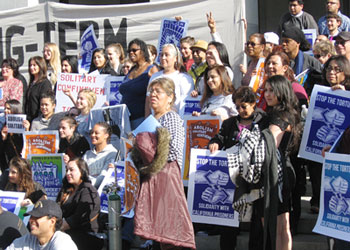(front page)
End solitary confinement!
demand Calif. protesters
Speakers at state hearing back prisoners’ fight

|
|
Militant/Betsey Stone
|
|
Supporters of California prisoners who held hunger strike last year protest after legislative hearing in Sacramento Feb. 11. Some 12,000 prisoners in the state are in solitary confinement.
|
BY BETSEY STONE
SACRAMENTO, Calif. — Supporters of the more than 30,000 California prisoners who were on a hunger strike last summer demanding an end to solitary confinement and prison abuses packed a state legislative hearing here Feb. 11.
About 200 people attended the hearing. Dozens of prisoners’ family members and others lined up to urge an end to solitary confinement of some 12,000 prisoners in California, including at least 3,000 in the notorious Security Housing Units known as the SHU.
“My brother has been in solitary for 30 years,” Marie Levin said when the microphones were opened for public comments. “Abolish the SHU! It’s inhuman! It’s torture!”
The hearing, organized by California Senate and Assembly Public Safety Committee chairs Loni Hancock and Tom Ammiano as part of an agreement that led prisoners to end their hunger strike last Sept. 5, focused on new policies enacted by the California Department of Corrections and Rehabilitation.
George Giurbino, retired director of the CDCR’s Division of Adult Institutions, testified in favor of the department’s new four-year “Step Down Program,” touting it as a pathway for prisoners to get out of the SHU. By going through a program that includes mandated instruction by prison authorities, renouncing gang activity, keeping a journal and not breaking prison rules, he said, prisoners could demonstrate they were no longer a security threat.
By taking these “steps,” new CDCR regulations say, inmates could get back into the general prison population “within three to four years.”
Prison officials refused to allow four members of the Pelican Bay Short Corridor Human Rights Movement, who helped lead the 60-day hunger strike in 2013, to testify, even by phone.
The four — Todd Ashker; Arturo Castellanos; Sitawa Nantambu Jamaa, who is Levin’s brother; and Antonio Guillen — wrote a statement that was read at the hearing, calling the new CDCR program “a sham.” They said it would continue to put prisoners in isolation indefinitely, based on unverified allegations from informants, or artwork, literature or communications the prison authorities deem gang-related.
“We were willing to starve ourselves to death rather than continue to endure these dehumanizing conditions forever,” the statement said.
“California is still unwilling to move to a real behavior-based system where prisoners are given determinate terms in solitary after due process hearings at which they are found guilty of some serious misconduct,” they wrote.
Craig Haney, a University of California professor panelist at the hearing, condemned the use of long-term solitary confinement as torture. “In sheer numbers, in the length of time served, it’s shocking,” he said. He called the Step Down Program “a step in the right direction that did not go far enough.”
Panelist Charles Carbone, a lawyer who has represented prisoners in solitary confinement, argued that the new plan makes the situation of prisoners worse. The Step Down Program has “coercive qualities,” he said, including requiring prisoners to keep a journal — open to the authorities — whose contents can be used against them.
The new rules actually expand the category of prisoners who can be thrown into the SHU to include any group of three or more people prison authorities say are a security threat. “With this, the number of people living in isolation will grow,” Carbone said.
Many of those who spoke during the public comment period expressed frustration at the lack of progress in getting rid of the SHU. “The CDCR is a law unto themselves,” said Constance Pedroza, whose son has been in the SHU for more than 15 years.
Other speakers emphasized the inhumanity of what the prisoners continue to go through — years of being locked in small windowless cells, without seeing the outside world or being able to touch their family members during visits.
Assemblyman Ammiano announced he was introducing a bill that would put a cap of 36 months on the time someone could be kept in the SHU. The bill would not apply to prisoners whose violations are categorized as “serious” by prison authorities.
Prison officials had slandered the hunger strike as “a ploy of the gangs,” former prisoner Steve Czifra told a rally following the hearing. In fact, he said, it was initiatives by the hunger strike leaders that led to a historic agreement for inmates to end hostilities between ethnic groups in the prison, to bring people together across cultural and racial lines.
“The leaders recognized a common bond, they got to know each others’ humanity while the state was creating divisions,” Czifra said. “We can come together and unite. This is the essence of the struggle.”
Related articles:
End solitary confinement!
| 


